Ever wonder how Sandakan or North Borneo like in 1922? This article written by a book writer described how life used to be in North Borneo.

The article appeared on Australian newspaper in 1922 after Thomas McMahon travelled to North Borneo. Armed with a camera, he took several shots of Sandakan and retold his experience there in vivid details:
The large island of Borneo, midway as it were between Australia and the Orient, is mostly under Dutch control, but has a resourceful northern portion being developed by a British chartered company, under British imperial protection, Sandakan is the chief commercial centre of this territory, and an interesting port of call of the Steamers of the Eastern and Australian Company.
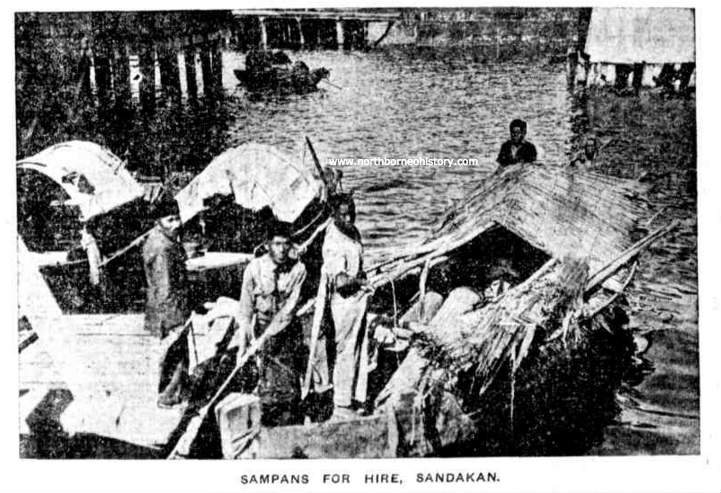
The entrance to Sandakan harbour is through massive red rock gates, on a bright day flashing vividly in the strong sunlight, and strikingly impressive. The harbour is deep, extensive, and sheltered, and is night and day, bright and lively in the numerous sailing junks, and queer little sampans or oar boats.
The junks, truly oriental objects, are most picturesque with their square brown sails, as they glide over the harbour in a swanlike, graceful, and stately mariner. No matter when or where a junk is seen it somehow makes a pretty picture. To watch one in the silvery rays of moonlight is to witness something that is perfect in pictorial effect. The sampans, manned by women, ferries by day and homes for families by night, bob about on the waves, and scurry over the water at un astonishing speed.
The town of Sandakan is not very large; and is on the side of, a great hill facing the harbour, the hill being terraced with fine roads leading to and passing the pretty residences of the British inhabitants. The business part of the tow is on the harbour, indeed, many of the streets, shops, and buildings are built on bridging over the waters. A fair size square is in the centre of the town, the one big jetty at one end, and an imposing building, the offices of the Chartered Company at the other. Rising to the hill is the post office, with its tall white, clock tower standing a little apart from the main building. Then comes a long low wooden build ing, the Bank of North Borneo, notable for the presence of an armed policeman marching up and down before the front door.

Above the bank on an other terrace street is a row of Government offices, embowered in a beautiful clump of tropic shade trees. About the jetty there is ever a wonderful scene of bustle, the harbour here is literally crowded with junks, big and little, packed together in a remarkable manner, thousands of coolies running up and down gangways loading them, to be despatched to tho many settlements along the North Borneo coast. The air is filled with the sing-song calls of the coolies as they work, carrying heavy loads, and seldom, resting, while the shrill cries of the sampan women demanding passengers is at times deafening.
STREET LIFE AT SANDAKAN
Tho population of Sandakan is composed of some 150 British, and several thousands of Asiatics, mostly Chinese. The bulk of the business, or the shop keepers, are Chinese, with a few Japanese, Indians, and Malays, displaying the wares of their respective countries. The shops, and there are hundreds of them, mere rooms in fact, are flimsy structures, of two stories. The streets are narrow, and with the shops crowded, as they always are, the scene resembles an ant bed that has just been stirred up.
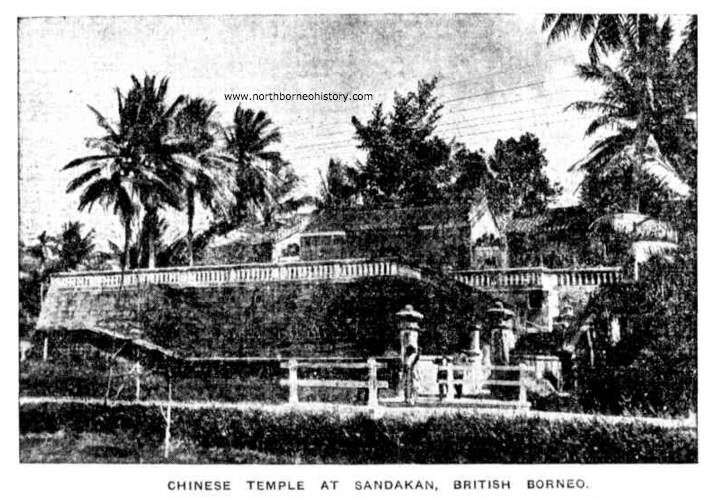
Men, women, and children move about in a keen, hurried fashion. There is a continuous pandemonium of noises in, the loud jabbering of voices, in the screaming tones of women as they talk from balcony to balcony, in the endless cries of hawkers, in the incessant din of gramophones grinding out Jazz tunes, which the Chinese love to hoar, and in the weird tinkling sounds of Chinese fiddles. Every shopkeeper in order to attract customers, either decorates his shop and wares with bright banner advertisements, or provides noises, musical, and otherwise.
Above all the clatter is the ever distinct, strange, and not unmusical sound, the clink-clank, of the wooden clogs worn by the people, as they walk striking the firm well made roadway; Notwithstanding the narrowness of the streets and the throngs, there is a constant stream of cyclists and motor cars, in contrast with the slow moving, and lumbering buffalo cart, more like a small house than a vehicle. These carts are drawn by heavy, black buffaloes, ponderous, deliberate creatures going at the rate of about a mile an hour, but they carry; with ease, loads that would tax the strength of a team of horses.
A funeral is an every-day affair, and goes through the street traffic causing little stir or reverence. The coffin is carried on long poles on the shoulders of coolies, and the paid mourners, mostly young girls, walk behind, walling and yelling in a perfectly hideous manner. Occasionally a new mourner, an apprentice as it were, is being coached by an old hand, who in order to make the mourner yell sufficient loudly, keeps thumping her on the back, indeed with such force as to make the yelling very genuine. In time the apprentice gets to under stand the pitch of yell required, and can start up a “mourn” at a moment’s notice.
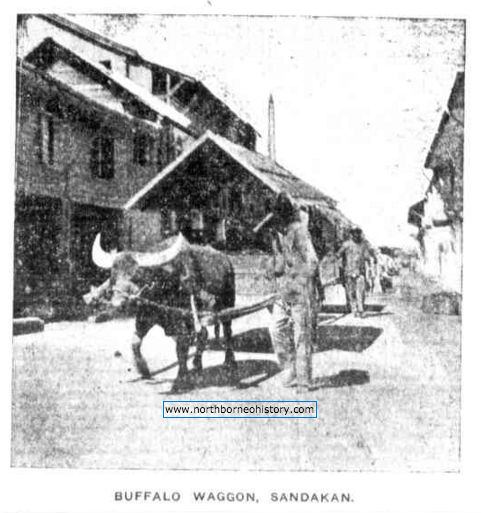
A quaint object is the Sandakan cab, either a bright green or yellow, and for all the world like a meat safe an wheels. A rat of a pony with harness more of string, and rope than leather, drags this cab, the Indian driver sitting on a high box seat, and so cramped up as to cause chin and knees to meet. The cab is intended to hold no more than four passengers, but there being no licensing laws to prevent overcrowding, it Is not unusual to see a dozen or more faros crammed’ In, hands, heads, feet and logs in a most ludicrous manner .showing out of tho roof, Windows, and sometimes tho bottom of the cab,
THE EAST BY NIGHT
Sandakan by night is a blaze of electric lights of many colours, and the streets and shops are througed more than ever. The streets and street corners are blocked with innumerable hawkers, jugglers, and acrobats. There are long rows of tiny stands covered with meat, fruit, and vegetables, , and every few yards in open air restaurants, around which sit coolies sipping tea, or soup, or enjoy ing a full meal of rice and fish. The street doctor is an interesting and busy person, he spreads out his medicines, and ointments, in small bottles and ‘tins and harangues the crowd as to their wonderful healing qualities, and his magic powers. He declares he can cure anything from a splinter in the big toe to the tormenting aches of a broken heart. A patient with a sore on his ankle presents himself for treatment. The doctor first burns various coloured papers, sacred money, to scare away evil spirits, and invoke the aid of good one, he next applies various ointments, binds up the leg, tells the patient to consider himself cured, takes his fee and calls for another subject.
LICENSED GAMBLING
Of the features of Sandakan the gambling “farms” are especially interesting. These are great, open, gaudily furnished buildings, filled with gambling tables. Gambling in this part of the world is not a crime, it is a business. A man having money to invest tries his luck at the “farms,” he wins’ or loses, the latter mostly, but, while he has a dollar he gambles. The “farms” are licensed under very drastic regulations, cheating or disorderly conduct if reported to the police means the loss of the license, and owners make far too much profits to take any risks.
The owners, Chinese always, make every effort to have their “farms” attractive, and popular. Every encouragement is given to wealthy and sporty gamblers, they are provided with board and lodging free while their gambling lasts. Attached to every gambling “farm” is a “pawnbrokers’ farm,” where gamblers may deposit their personal belongings at reasonable rates, and so continue to gamble until every cent is gone. A broken gambler never goes away from the “farm” without a few dollars in his pocket, which the owner gives him to take him home, or guarantee him meals and bed for a day or so.
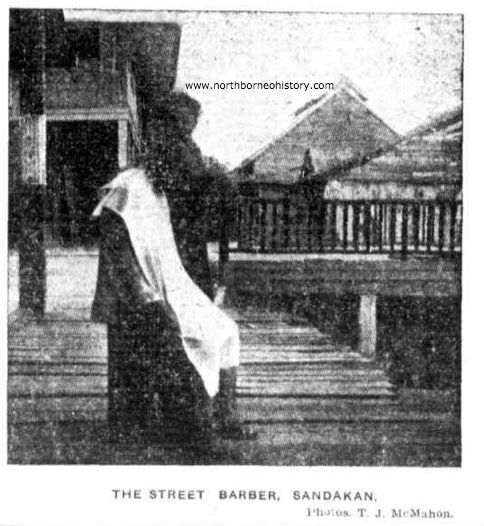
The gambler when again flush of money does not forget the good turn, and returns to give the “farm” owner every opportunity of getting his money back, and with interest. That “farms” go on night and day and are over crowded; there are relays of supervisors, counters, and servants; the rattle and chink of money can bo heard at all hours. At night the “farms” are gorgeously lighted up, and then are positively thronged, the tables being very busy. The most seductive signs invite people from the street’s; the most polite signs pointy to the table, the public and private rooms. There is feeling of eager excitement, but all is carried out in quiet and orderly manner.
The Chinese counters and collectors handle money in the most expeditious and accurate way. The gambler winning is a hero, and is acclaimed by the crowd; the gambler losing fights his own battle, he is haggard of face, he ponders, on every move, he never stakes but he utters a prayer for success, and when his last dollar is gone lie slinks away little noticed. Boys and old men, rich merchants, and coolies sit side by side at the tables come and go night and day, early and late. The law of Sandakan allows full freedom to Asiatics to gamble to their hearts’ content, but British residents are forbidden to gamble in the “farms,” though visitors off steamers occasionally do just for the novelty of the thing.
BLACK SMOKE
In contrast to the glare and crowds of the gambling “farms” are the opium dens, dark and uninviting. Fortunately there are but few, and the law is gradually weeding out and treating the unfortunate people addicted to this pernicious drug. Men of tho coolie class mostly go to the dens, to seek relief from their worries. Behind a counter in one corner of the room a man hands out long pipes with the doses of opium required; the smoker reclines on a hard wooden couch. There are several of these couches round the room. A few draws of the pipe and all troubles are forgotten, the dark, noisome, surroundings give place to comfort and elegance, opium dreams produce beautiful beings and objects, the hard couch becomes a bed of the softest and sweetest scented cushions, the world is happiness and contentment, But the face of the Brnolcer is drawn thin and pale; he rises from his wonderful dreams a miserable and emaciated creature.
SHY, HARD-WORKING WOMEN
The streets of Sandakan are usually filled with women, from the Chinese lady in bright silks to the coolie in their black breeches and jackets, and their large straw hats with long black drapes; very much to be compared to stand-lamp shades; The coolie women work equally as hard as the men, they dig and blast in the quarries, push wheelbarrows, manage trucks, carry, heavy, baskets of fruit and vegetables. They are shy creatures and shrink away from a camera man. It is amusing the way they pluck off their, hats to cover their faces, when the camera is pointed at them, forgetting the hats have no crowns!
WILD MEN FROM BORNEO
Surrounding Sandakan, and within a live mile radius is a mass of rich tropic jungle, which is interesting in many kinds of wild animals, herds of elephants, and troops of monkeys frequently to be seen. While motorcar drives are numerous and beautiful, for sixpence an hour, first class bicycles can be hired, and then interesting rides taken along the harbour shores, and to the native Malay villages. The “Wild Men of Borneo,”as heard of in song, are today busy in many occupations, principally fishing.
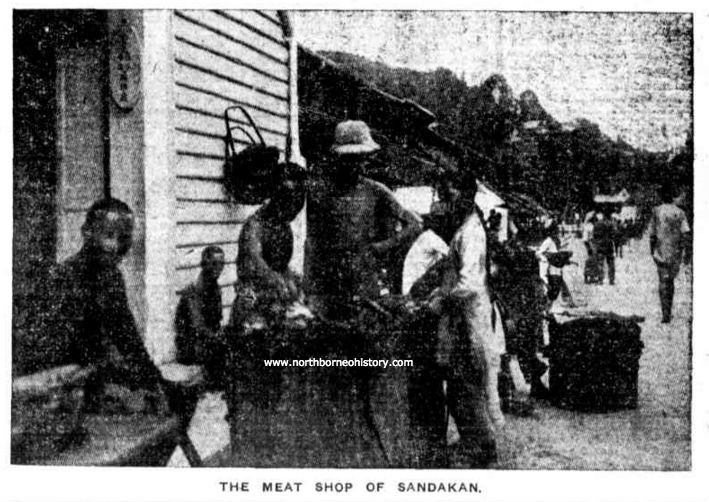
AUSTRALIAN TRADE
Australians should be interested in British Borneo, as there is quite an extensive trade being done with the Commonwealth in meat, flour, and food products. In return very valuable timbers are sent to Australia. Whatever may be the faults of a Charter company, there is no question, North Borneo has been made prosperous in trade, and the just and proper exploitation of the rich 1 resources of tho country, which are mainly timbers, coal, and precious minerals. The company is progressive, and successful, and it has the reputation of being liberal and humane with its employees. Certainly Sandakan has a very decided air of solid prosperity. The Government of North Borneo is carried out under British Government supervision, the Governor and officials being paid from the revenues of the company.
*** End ***
Anyone interested to make a movie out of this?
Related Posts
Leave Your Comments
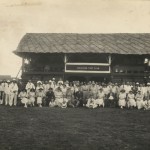
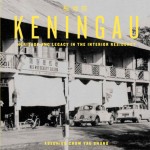



Dear Richard Ker,
i read your article about Sandakan and I feel compelled to share a story about a woman name Dyg Sharifah Kalasahan Binti Pengiran Taha from Kg. Bakarah, Sandakan
She was a tax publican from the area of Tanah Merah until Kg. Gelam currently known as bandar Sandakan (specifically around the Sandakan Townhall now situated. She used to make tax collection from door to door at the Chinese shopkeepers. The shopkeepers used to call her ‘Mama Lajah’ or the king’s mother.
Should you feel interested to know more of the story please feel free to contact me at this number: 011 126 126 91
sure! please do share
Dear Sister Fauzia , I am a member of the Rajah Sharif Osman and Rajah Sharif Yasin of Kota Marudu , a capital then of North Borneo or 2nd district of the Sultanate of Brunei , thru his daughter Sharifa Muratun / Dayang Tata with mother from Johore as Sharif Yasin had 4 wives . The mother of Rajah / Sultan Yasin is Sultan Shakirullah of Sulu.See Sultanate of Sulu and Brunei . Our ancestor predicted that a direct heir from his 7th generational heirs will emerge to revive his kimdom and tasawwuf teachings . May you please up-date me if you are also a descendant and your relative .Thanks
Aslam. I like your dialog. I wish I ll be informed of your ancestors , the ancestors of that mama lijah , a collector in Sandakan under a pengiran taha, who must decend from rajah sharif yasin in marudu 1882, son of rajah sharif osman 1845 as recognized by Singapore governor of britain and ireland and Spanish governor in manila .
Dear Sister Fauzia , I am a member of the clan of Rajah Sharif Osman and Rajah Sharif Yasin of Kota Marudu , a capital then of North Borneo or 2nd district of the Sultanate of Brunei , thru his daughter Sharifa Muratun / Dayang Tata with mother from Johore as Sharif Yasin had 4 wives . The mother of Rajah / Sultan Yasin is Sultan Shakirullah of Sulu.See Sultanate of Sulu and Brunei . Our ancestor predicted that a direct heir from his 7th generational heirs will emerge to revive his kimdom and tasawwuf teachings . May you please up-date me if you are also a descendant and your relative .Thanks
Dear Richard Ker / Sharifa Dayang Fauzia , I would be elated if you can share me untold history of that 2 Kota Marudu rulers .Thanks.
The Real History of North Borneo King Sharif Osman
4th North Borneo Sultan Sharif Osman [1830 to 45] succeeded his father Brunei Pengiran 3rd Sultan Sharif Md Salleh son of 2nd Sultan Md Daud son of the founding Sultan Abdul Wahab of the then 1795 Brunei Empire’s 2nd Division [ North Borneo , now State of Sabah Darul Afiyah , Malaysia ] who inherited the off-shoot North Borneo sultanate from his father 20th Sultan Omar Ali Saifuddin [SOAS] I of the undivided Brunei empire from 1740 to1795 .He descended directly from the warring early Brunei Sultans Abdul Hakkul Mubin , Mohyuddin and Muhammad Ali.
In “Thus Has Marudu Ceased to Exist:The Rise and Fall of a North Bornean Kerajaan” written by German Doctor Bianca M. Gerlich , it thus partly said : “Syarif Osman was said to be generally in the possession of supernatural properties and invulnerable: “as he[Syarif Osman], being one of those whom they deem invulnerable, exposed himself to every fire, and fought to the last” (S. St. John 1862: II, 207).
Malaysian authors considered Syarif Osman as a hero who was brought down by the British: “Matilah seorang pahlawan keturunan darah Raja akibat pengkhianatan dan hasutan Inggeris”(Buyong 1981: 15).
In the book Commemorative History of Sabah 1881–1981, edited by Anwar Sullivan and Cecilia Leong, which was published by the Sabah State Government on the occasion of the 100th anniversary of Sabah, Marudu was described as an independent chiefdom whose interference in the politics of Brunei led to Vice Admiral Cochrane declaring Marudu as a pirate stronghold and destroying it. Nevertheless, Nineteenth Century [19th] colonial officials were already in doubt as to the representation of Osman as a pirate. Thus Bulwer wrote: “Yet it is very doubtful if he [Osman] was guilty of the charge brought against him as a pirate ”
Even Captain Belcher, who sailed with Brooke to Brunei in 1844 and who in his letters to the Admiralty supported Brooke’s defamation of Syarif Osman, came to a different assessment in his book after having learnt in Manila of the real behavior and motivation of Syarif Osman: “At Maludu Bay, in particular, the destruction of Seriff Housman has deprived the people of that region, of the only energetic ruler who could have afforded protection to European traders” (Belcher 1848: II, 124). Before Syarif Osman was defamed by Brooke he was recognized as ‘Rajah of Maloodoo’ by Governor Butterworth of Singapore (Belcher 1848: I, 170), and even Pascoe, who took part in the Battle of Marudu as an officer, described him as Rajah (Pascoe 1886:
He was recognized by European government officials such as Spanish General Claveria of Manila and British Governor Butterworth of Singapore, as well as by local neighbors. Syarif Osman cultivated very good relations with the two directly neighboring sultanates of Brunei Darussalam [ First Division of the Brunei Empire] and Sulu. He was married to a pious lady Dayang Sahaya who was reportedly crossing rivers at the surface , a daughter of the Sulu Sultan Shakirullah [ who personally governed Sandakan for 19 years before becoming a Sultan [1822 -23] and a Rajah Muda [1808-1822] , Warren] of Sulu and was a friend of her brother, the heir to the throne Rajah Muda Muhammad Buyong . Sulu had not only acknowledged Marudu to Sulu, but found it a reliable partner in troubled times. Syarif Osman was also accepted at the court of Brunei. He was a friend of Pengiran Usop, who exercised effective control in Brunei in his position as bendahara , the Crown Prince Pengiran Anak Hashim and other Brunei nobles .
Marayaw bang kita niyu maka pag kila.
pls contct me +60128116710
Magsukul
Thank You
Marayaw bang kita niyu maka pag kila.
pls contct me +60128116710
Magsukul
Thank You